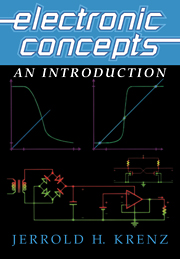Book contents
- Frontmatter
- Contents
- Preface
- 1 ELECTRONIC SYSTEMS: A CENTURY OF PROGRESS
- 2 THE SEMICONDUCTOR JUNCTION DIODE: THE BASIS OF MODERN ELECTRONICS
- 3 THE BIPOLAR JUNCTION TRANSISTOR: AN ACTIVE ELECTRONIC DEVICE
- 4 THE METAL-OXIDE FIELD-EFFECT TRANSISTOR: ANOTHER ACTIVE DEVICE
- 5 NEGATIVE FEEDBACK AND OPERATIONAL AMPLIFIERS
- 6 ELECTRONIC POWER SUPPLIES
- APPENDIX A FABRICATION OF INTEGRATED CIRCUITS
- APPENDIX B THE DESIGN PROCESS
- Index
3 - THE BIPOLAR JUNCTION TRANSISTOR: AN ACTIVE ELECTRONIC DEVICE
Published online by Cambridge University Press: 05 June 2012
- Frontmatter
- Contents
- Preface
- 1 ELECTRONIC SYSTEMS: A CENTURY OF PROGRESS
- 2 THE SEMICONDUCTOR JUNCTION DIODE: THE BASIS OF MODERN ELECTRONICS
- 3 THE BIPOLAR JUNCTION TRANSISTOR: AN ACTIVE ELECTRONIC DEVICE
- 4 THE METAL-OXIDE FIELD-EFFECT TRANSISTOR: ANOTHER ACTIVE DEVICE
- 5 NEGATIVE FEEDBACK AND OPERATIONAL AMPLIFIERS
- 6 ELECTRONIC POWER SUPPLIES
- APPENDIX A FABRICATION OF INTEGRATED CIRCUITS
- APPENDIX B THE DESIGN PROCESS
- Index
Summary
Several types of transistors are used in modern electronic systems, both individually as discrete devices and in conjunction with other transistors in integrated circuits. Transistors have three or more terminals and, as is the case for junction diodes, transistors are nonlinear elements. The bipolar junction transistor (BJT) that will be discussed in this chapter, as well as the field-effect transistor of the next chapter, are active devices. Electronic amplifying circuits in which a small input voltage, current, or both, produces a larger output voltage, current, or both depend on active devices. Amplification is required for nearly all electronic systems. The analysis of transistor circuits is considerably more difficult (a greater challenge) than that of circuits with two-terminal passive elements – resistors, capacitors, and inductors.
The history of active electronic circuits dates from the invention of the vacuum tube (the audion) by Lee De Forest in 1906 (De Forest 1906). From the very beginning the challenge was to develop circuits to utilize this new device. Edwin H. Armstrong was foremost among the early designers of electronic circuits that were initially used to improve wireless communication (Armstrong 1915). The junction transistor, developed in 1950 (following the invention of its predecessor, the point-contact transistor, in 1948), and other transistors, have replaced vacuum tubes for most (but not all!) applications. These applications, however, tend to rely on electronic circuits similar to those initially used with vacuum tubes (Electronics 1980).
- Type
- Chapter
- Information
- Electronic ConceptsAn Introduction, pp. 133 - 216Publisher: Cambridge University PressPrint publication year: 2000



